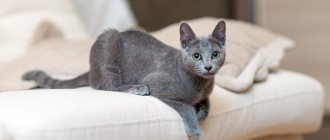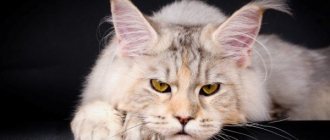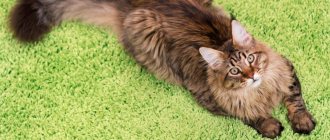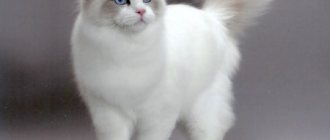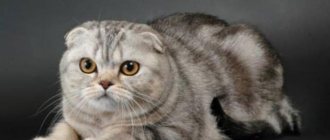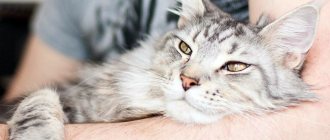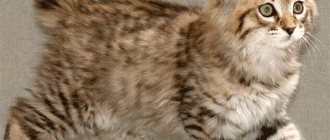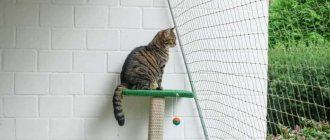The tail of a Scottish cat is an indicator of health: flexibility and length will tell you whether there are problems with the musculoskeletal system. This is why it is so important to inspect the tail when choosing a kitten.
Article continues after advertisement
The tail of a healthy Scottish cat should be long enough, flexible, not thick, without kinks or damage. Towards the tip it gradually becomes thinner, fading away. Scottish cats bred according to the American standard can especially boast of such tails. In breeding programs in the United States, where the breeding of this breed was transferred in the 20th century due to its ban in Europe, males and females with elongated tails participated.
Breeders tried to develop healthy lines that were not susceptible to a disease such as osteochondrodysplasia, caused by a gene mutation in Scottish Fold cats. This mutation also affects the tail vertebrae: it affects the intervertebral discs, causing the tail to become short, thick or broken. Cats with a long and flexible tail are considered healthy according to this parameter. As a result, it was they who participated in the selection and it is these individuals that are valued today.
However, in our latitudes everything is not so rosy. Many breeders cross cats incorrectly and end up with sick offspring. In addition, the children of a correctly selected couple are not immune from the occurrence of an anomaly, it’s just that in them the disease is much less common and is not so pronounced.
For a hook on the tail, a short and motionless tail at an exhibition, cats will have their marks reduced and even disqualified, because... This is a serious defect, critical for the Scottish breed.
Let's look at the main types of deformation and understand what causes them.
Some cats live without tails
Cats lack a tail for two reasons: after injury or due to the characteristics of the breed. If a cat has lost its tail due to injury, then at first it will be uncomfortable and unusual for it to move. Gradually, the cat gets used to living without a tail: the cat’s coordination and movement return to normal.
Some cats lack a tail - a feature of the breed. These breeds include Japanese, Kuril and American bobtails, as well as Manx. These breeds live well without a tail. Nature has endowed them with a strong body and muscular hind legs.
The Scottish Fold cat has a kinked tail.
What ordinary people call a crease is not always the correct word. Veterinarians identify tail abnormalities that can be confused with a kink: kink and bend. We will not go into a description of each type, because... This won't mean much to the average person. But look at the picture.
It is difficult for the owner to determine the type of anomaly by touch and visually; this can only be said for sure after an x-ray.
Most likely, with such a deformation we are dealing with a congenital anatomical defect. In this case, the veterinarian takes an x-ray of the entire spine. You may also need x-rays of your extremities. Only after this and a number of other studies is a diagnosis made.
If the problem is limited to the tail, then a similar anomaly occurs in all breeds, not just Scottish cats. And it can manifest itself in both folds and straights.
Where do such deformations come from? The first possible cause is trauma, or rather dislocation of one of the caudal vertebrae. Then the deformity is eliminated with a slight movement of the veterinarian’s hand: the vertebrae fall into place.
But more often the cause of the deformity is a congenital anomaly in the structure of the vertebrae, which occurs in the embryo at the beginning of pregnancy. This may be a hereditarily transmitted anomaly, or it may be a mutation that occurs by chance. It is facilitated by viral diseases of a pregnant cat and the use of certain medications during pregnancy.
In many cases, such a mutation is only one of the problems: as experience shows, tail abnormalities are often accompanied by abnormalities in the development of the heart, kidneys and genitals. This is why it is so important to conduct a full examination of the animal if problems with the tail are identified. Moreover, these deviations may not appear at the same time, so the cat will have to be examined regularly for preventive purposes.
Cats and tomcats with abnormalities in the structure of the tail, with rare exceptions, are removed from breeding so that they do not give birth to sick offspring. This is done because, even if the parents have no other problems other than a “broken” tail, they will pass the anomaly on to their children - and in them it will be associated with diseases of the entire musculoskeletal system and internal organs.
The tail has a separate tongue
A cat's tail has 9 basic positions:
- the tail is tousled and lowered - the cat is scared;
- raised tail - greeting, joy of meeting;
- a drooping playful tail means the cat is in a bad mood. It's better to leave him alone;
- a raised tail with a curved tip - the cat is happy and wants to be friends;
- a raised slightly vibrating tail - the cat is excited and happy to see you;
- the tail is pressed to the bottom - a feeling of fear or guilt. Apparently the cat was acting up;
- the tail is raised and ruffled - strong excitement or a feeling of threat;
- the tail is curved along the body - the cat is in love.
Check out our infographic to understand exactly the language of a cat's tail.
Love your cats and take care of their tails!
Did you like the article? Share with your friends!
Lump (growth) on the tail
Sometimes there are growths or bumps on the tail of cats. They are usually invisible upon examination, but can be felt when palpated. Felinologists and breeders cannot express a common opinion. Some people think that this is due to poor drinking water, others think that it is enough to give a massage to make the problem disappear, and others recommend changing the food. However, the approach when the owner felt a lump and instead of going to the veterinarian began asking felinologists is fundamentally wrong: serious research is needed here. Let us explain why.
There are too many reasons for the appearance of a tail bump to try to make a conclusion based on inspection alone. This could be an almost harmless bone abnormality, or it could be cancer, a site of accumulation of subcutaneous parasites, an abscess and other reasons. Therefore, a trip to the veterinary clinic is mandatory.
If a cat does not have a bump on its tail, but a larger formation that is shaped like a boa constrictor that swallowed a rabbit, then most likely it is a nodule formation, that is, the fusion of two or more vertebrae.
But in any case, you need to check with a veterinarian. You cannot make a diagnosis on your own! Moreover, if we are talking about vertebral fusion, then the visit could be postponed, but what if it is a tumor? If it is cut out at the benign stage, the animal can be saved. And if it develops into cancer, then it’s no longer a fact.
History of development
The ancestors of the Mekong Bobtail are Siamese. Despite the fact that the first mentions of animals with the Siamese color, but with a short and curved tail, were found already in the 20th century. and even before, the breed was not recognized for a long time. Cats with a broken tail were considered a waste.
Only at the end of the last century did breeders from Russia begin to seek recognition of the short-tailed Siamese as a separate species. The first standard was developed and adopted in the mid-90s. And it was finally adjusted and approved in 2004 in Germany. The breed received an official name and was classified as the Siamese-Oriental type.
We recommend viewing
Do cats mate with their siblings? Do cats miss their owners when they are returned home? Black Cats
The Egyptian Mau can be easily identified by the fur patches that appear only at the tips of the fur. In addition to these spots, the Mau also has rings on its tail. These rings increase in width until the tip becomes completely black.
Known as the fastest domestic cat breed, the Egyptian Mau's patterned tail is essential for speed and agility. The Mau is a compact, muscular cat with a medium-length body. What this breed lacks in grace, it makes up for in grace. The Mau's powerful muscles combined with its long tail allow it to move and turn quickly.
In addition to quick reflexes, this breed's legs are also designed for speed. The Mau's hind legs are longer than the front ones. Between the knee and hind knees is a flap of skin that allows the Mau to extend its legs faster and run at high speed. This breed reaches speeds of over 30 miles per hour.
Thanks to the Mau's tail, this breed is known for another interesting quirk: the "wagging tail." This is when the Mau wags and twitches its tail as a sign of happiness. This behavior is accompanied by what appears to be spraying, although the Mau does not excrete urine when doing so. When resting, the Mau's tail swings lazily back and forth.
Maine Coon
This breed holds the record for the longest cat tail. Additionally, the Maine Coon is known for its large body and gentle nature.
The Maine Coon has a distinctive coat along the chest, a rectangular body shape and a strong bone structure. The Maine Coon has a two-layer coat, which looks even thicker due to its unevenness. She also has long guard hairs with a silky undercoat. All this allows the Maine Coon to survive in cold conditions.
This adaptation extends to the Maine Coon's tail. The tail, like the fur, appears thick due to the bushy fur. The tail is very long and is designed for protection in cold climates. In frosty weather, the Maine Coon may wrap its tail around its face and shoulders. This reduces body heat loss and protects the cat from cold air and snow.
Nebelung
The first Nebelungs were called Brünnhilde and Siegfried, a queen and warrior in the German saga Nibelungen-Lied. The breed's name comes from this saga combined with the German word "Nebel", which means "fog". Exuding an air of mystery at first glance, the name Nebelung suits this mysterious-looking breed.
The Nebelung is descended from the Russian Blue, as evidenced by the bluish-gray coat of the Nebelung. Unlike the Russian Blue, the Nebelung has a shaggy, semi-long coat. Its eyes can range from green to yellowish-green in color. This striking coloration is combined with a long neck, body and legs.
Due to its body length, the nebelunga understandably has a long tail. However, unlike most breeds, the Nebelung has a tail that is even longer than its body. Thanks to this, the breed is famous for having some of the longest tails of all cats.
The Nebelung is a relatively new breed, only created in the 1980s. For this reason, a small number of these cats are found throughout the world. Wherever there is a nebelung, it continues to attract the attention of owners with its long tail and charming color.
First aid
If it is not possible to take the cat to the veterinarian immediately, you should try to help the pet yourself. First of all, you need to clean the wound of dirt. Boiled water or saline solution is suitable for these purposes. It is very important that nothing gets into the wound, otherwise the risk of infection increases. Therefore, the hair around the wound must be carefully trimmed so as not to cause hair loss.
The next step is to apply ointment to the edges of the wound. Levomekol, ichthyol or tetracycline ointment are suitable for these purposes. There is no need to rub the product into the wound. A thick layer of ointment covers the injured surface with an oily film and prevents the necessary oxygen from entering.
After all these procedures, cover the wound with a piece of soft and clean cloth and begin to apply a bandage. This stage is usually the most difficult. It is important to fix the bandage in such a way as not to block the access to air and at the same time not to pinch the important vessels of the tail. In addition, you need to avoid a situation where the cat throws off the bandage from the injured area. If the owner cannot cope with all these manipulations on his own, one of the family members should be enlisted to help.
In the following days, you need to monitor the condition of the pet’s tail and behavior. If the bandaged fabric is moderately covered with blood stains, it means that the healing process is proceeding normally and the owner can only systematically change the bandage. If pus mixed with blood oozes from the wound and an unpleasant odor emanates from the wound, the cat should be immediately transported to a veterinarian.
To prevent a situation in which the cat's tail is broken, the owner should pay increased attention to his pet. Avoid injuring the animal by closing the door. Make sure that the cat's tail is not damaged while playing with other pets (cat, dog or puppy). Protect the animal from falls from heights, impacts and other dangers. Compliance with these conditions is the key to the beauty and correctness of the cat’s tail.
Source
Features of character and behavior
The character of the Mekong Bobtail is more dog-like than cat-like. Representatives of the breed can easily be taught simple commands and walking on a leash. They love to carry small things in their teeth, so the “fetch” command is real fun for them.
Cats are very inquisitive and sociable. They become strongly attached to their owners. They always strive to be aware of the events happening in the house and follow on the heels of their owner. Animals have a pleasant timbre of voice - they do not miss the opportunity to “talk” with a person.
Cats, when treated with respect, will never show aggression or scratch. But, if the behavior on the part of an animal or person is too intrusive, they may begin to bite in defense of themselves.
An interesting feature is the obvious differences in the behavior of cats and cats. Females are more independent and proud. Oddly enough, males are more often involved in raising offspring. Cats play only the role of an outside observer. If something doesn’t suit them, they start to grumble or hit their other half with their paw.
Mekongs are very playful and active. They are also excellent hunters. Therefore, if the family already has parrots, fish or small rodents, it is better not to buy a bobtail. He will not miss an opportunity to catch his “prey.”
Genetics of the Kurilian Bobtail tail
One of the rarest features of such an interesting breed as the Kuril Bobtail is, of course, its unique tail.
Kurilian bobtail cat
Since the Kurilian Bobtail is one of the fairly young breeds, talking about the genetics of the Kurilian short tail will not be easy. The fact is that almost no one has carried out control crosses of Kurilian bobtails with ordinary tailed cats or bobtails of other breeds. The prevailing opinion was that the Kuril tail mutation is dominant and has a polygenic inheritance pattern. Unplanned, rare crossings of Kurils with representatives of long-tailed breeds showed that short-tailedness is inherited very heterogeneously in the offspring. Some kittens had a tail of almost normal length and only a few vertebrae were slightly deformed. Other offspring had a pulled back bobtail and still others had a true short Kuril tail. There were no kittens with true long tails without any kinks in the litters. However, it is difficult to say that such kittens could not have been born, since, as we have already said, the number of such “interbreed” matings was very small and did not provide sufficient statistical material for any substantiated conclusions.
Kurilian bobtail cat
Of great interest is the little-known information among breeders about several matings of Kuril Bobtails with Thai Bobtails. It goes without saying that the tails of representatives of these two breeds have a different genetic nature, since from almost every mating in a litter you can find a kitten with a completely ordinary straight tail, and even of normal length. As for the rest of the kittens, almost all of them have short tails. As a rule, these are from two to four vertebrae with many fractures. Sometimes such matings gave birth to completely tailless kittens, which at the same time did not have fusion of the sacral vertebrae and other changes in the skeleton that are inherent in the Menx mutation of taillessness.
The tail of the Kurils resembles a bean
The pedigrees of some “Kurilians” indicate that they also had Japanese Bobtails in their family. Unfortunately, such matings cannot be called indicative, due to the fact that many Japanese bobtails of the Russian “spill” originated from the same Kuril Islands. Therefore, it would be overly presumptuous to claim that their tails have a completely different genetic basis from others. In theory, if we assume that the Japanese short-tailed cat is of a recessive nature, then the kittens should have the same split in tail length as in the case of a mated cat with a long-tailed cat.
The Kurilian Bobtail is a native breed. Nature has given us amazing cats with excellent character.
Only the second generation of cats can demonstrate the effect of the combined action of these genes. There is a fairly widespread opinion among geneticists and breeders that at the stage of formation of the breed, native long-tailed cats and Japanese short-tailed cats were crossed. Is this true? Today, getting a clear answer to this question is very problematic, if not impossible. Perhaps, when the Kurilian short-tailed mutation is studied to a greater extent than now, the answer to this question will finally be obtained, but it is much more reasonable to make the assumption that the short-tailed mutations of Japanese and Kurilian cats arose independently of each other, spontaneously. Although the factors that caused these mutations could be exactly the same.
It is possible that short-tailedness is associated with gene mutations
These were questions concerning theory, but for our breeders it is much more important to know how tails are inherited among the Russian, I must say, very heterogeneous population of Kuril “bobbies”. It is quite problematic to provide comprehensive statistics here, but it is quite possible to trace the most important patterns.
For fairly long-tailed females, whose tail reaches 8-12 centimeters in length (this can be a retracted bobtail or a panicle), it would be best to choose a very short tail or a “spiral”. This is done in hopes of producing short-tailed offspring. So what's going on? Typically, one kitten will have a "retracted bobtail" while the rest of the litter will have various "coils" ranging in length from two to six centimeters. This can be considered progress. However, in order to speed up its progress, it is necessary to exclude from breeding kittens with a “retracted bobtail” tail, since from the standpoint of the breed standard such a tail structure is considered a disadvantage. However, in practice, this happens extremely rarely, since all Kuril bobtails (with any tails) are literally in abundance in our country, and we cannot yet afford to waste breeding material in such conditions.
Kurilian bobtail baby
The so-called “tail stump” is extremely insidious. An animal with such a tail, as a rule, has a strongly “raised” croup and a slight hump in the spine. Mating with animals with this type of tail is fraught with the fact that the litter will have an increased percentage of tailless kittens or kittens with a reduced number of vertebrae. And neither one nor the other, again, meets the standard. It is good to use a cat to shorten various “panicles”, but the offspring, again, will be very heterogeneous and kittens of the same litter will be both long-tailed and tailless.
Spiral tails have the greatest stability in inheritance. If you breed two “spiral” sires, then the kittens will be quite similar, and there will be no individuals with extreme tail lengths (either too long or too short). It is quite possible that in further selection preference should be given to individuals with such a tail. In such animals, the croup is smoothly raised and lacks a humpbacked spine (if any is present, then to a very small extent). When palpated, the tail of such animals is not painful at all.
Bobtails are actively used for mating with long-tailed cats
Retracted bobtail or whisker tails are often classified as continental bobtails. It is quite possible that this type of tail is somehow connected with long-tailed cats, whose blood flowed into the population during the formation of the breed. In cases of importing indigenous animals, it is almost impossible to control this point. However, this is just a guess. Predictability in matings for such tails is also quite difficult. Sometimes mating with inbreeding to a sire with a tail-whisker can produce kittens with a short tail (which partly confirms the assumption that tail inheritance is polygenic), but cannot help in understanding the processes of inheritance.
Today, all breeders of Kuril cats should join their efforts, since our fragmentation so far has only been to the detriment of this wonderful breed. Everyone knows that it is very difficult to find excellent animals on the islands, and organizing expeditions is both difficult and expensive. Breeders have to be satisfied with the little that falls into their hands with scientists or military personnel returning from business trips, who, when selecting kittens, are guided more by feelings than by the standard of such a wonderful breed as the Kuril Bobtail.
If you find an error, please select a piece of text and press Ctrl+Enter.
Care and maintenance
Bobtail care is minimal. The pet is clean and keeps its short fur in order. The owner should only brush the cat during the shedding period. Representatives of the breed do not tolerate water, so they do not need to be bathed often. Water procedures can be replaced by wiping the wool with wet wipes. Animals have a weak undercoat, so they do not tolerate being kept in a cold room.
From a very early age, kittens are taught the following hygiene procedures that are mandatory for all cats:
- dental examination;
- eye wash;
- ear cleaning;
- trimming claws.
Mekong Bobtails have very strong immunity and good health, so they are not prone to hereditary diseases. They can reproduce even at a respectable age for cats - 20 years or more. Provided regular care and a properly formulated diet, visits to the veterinarian will only be of a preventive nature.
Why can't you tug and pull?
A long tail is not just an ornament, but also an important part of a cat's body. It is a continuation of the spine and is penetrated by many nerve endings. Therefore, any careless handling of the tail can cause its incapacity. Injuries to this part of the body negatively affect the functioning of the pet’s intestines, kidneys, hind legs and reproductive system.
Important! Many cats do not allow their tail to be touched at all, instantly taking up a defensive position. And with frequent attempts to tug on it, pets may begin to take revenge, leaving puddles in the wrong places.
How to feed your pet
The Mekong diet is not too different from the diet recommended for Siamese cats. When purchasing ready-made food, you can buy mixtures intended for Siamese. Kittens are accustomed to this diet gradually. First, kids eat fermented milk products (cottage cheese, kefir) and finely chopped meat. After half a year, they gradually switch to an adult diet.
When feeding natural food, you should not overfeed your pet with meat products or fish. This may cause the color to change. It is better to diversify your diet with dairy products, vegetables and fruits. This way the Mekong will receive a sufficient amount of vitamins and microelements.
Structure and shape of the tail
The cat's tail is an extension of the spine and, depending on the breed, can grow up to 40-50 cm and have up to 27 vertebrae. It is divided into 3 main parts:
- Root. It starts right from the sacrum and includes 4-6 wide fused vertebrae.
- Stem. It consists of 10-15 elongated vertebrae, between which there are connective cartilages. The voids around the cartilage are filled with jelly-like intervertebral fluid. Thanks to this structure, the cat's tail is flexible and can take on different shapes.
- Tip. It consists of short and thin vertebrae, on one side of the last of which there is no connecting cartilage and articular surface.
Due to the high mobility of the ligaments and tendons that make up the cat's tail, it can curl into a variety of shapes without causing damage to the animal.
Host actions
What should an owner do if he discovers that his pet has a broken tail tip, base or middle part? The procedure depends largely on the duration of the injury :
- Old kink . Sometimes the fact of injury goes unnoticed by the owner and the tail gradually heals on its own. In this case, if nothing bothers the pet, no measures need to be taken.
- "Fresh" injury . The situation is completely different if the cat’s tail injury occurred just recently and was quite serious.
Putrefactive bacteria can enter the wound, after which suppuration and foul-smelling discharge will begin.


